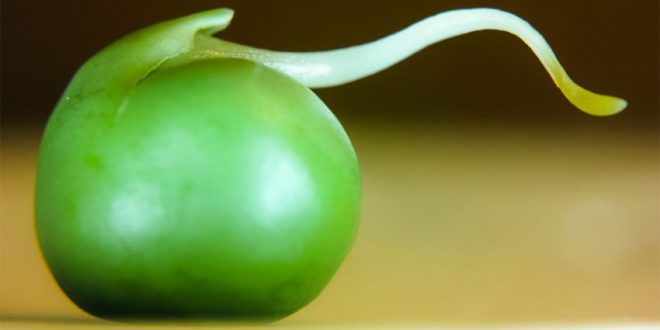Recent study shows that pea plants are the only vegetables that are able to take any chances by means of adapted responses to their surrounding environment.
In the study, published in the journal Current Biology, pea plants were grown with their roots split between two pots, thus facing the decision of which pot to prioritise.
In a preliminary experiment, the researchers showed that the plants grew more roots in a pot endowed with higher levels of nutrients – an adaptive response similar to animals allocating greater foraging effort to richer food patches. In a series of follow-up experiments, they then split the roots of each plant between two pots that had equal average nutrient concentrations, but where one pot had a constant level and the other a variable level, asking whether plants would ‘prefer’ to grow more roots in one or the other.
Based on theoretical analyses of how decision makers such as humans or animals respond to similar choices, the researchers predicted that plants might prefer the variable pot (ie be risk prone) when the average nutrient level was low, and the constant pot (ie be risk averse) when average nutrient level was high.
This is because when the average nutrient level is below what is required for the plant to thrive, the variable option at least offers the chance to ‘gamble’ on a run of good luck. On the other hand, when average conditions are good, it makes sense to take the safe option.
The scientists found that this is exactly what the pea plants did.
Co-author Professor Alex Kacelnik, of the Department of Zoology at Oxford University, said: ‘To our knowledge, this is the first demonstration of an adaptive response to risk in an organism without a nervous system. We do not conclude that plants are intelligent in the sense used for humans or other animals, but rather that complex and interesting behaviours can theoretically be predicted as biological adaptations – and executed by organisms – on the basis of processes evolved to exploit natural opportunities efficiently.
‘We do not yet know how the plants’ sense variance functions, or even if their physiology is specifically adapted to respond to risk, but the findings lead us to look even at pea plants as dynamic strategists and to model their decision processes just as one would model an intelligent agent.’
A human example illustrates the problem facing the pea plants: if you have a choice between a guaranteed $800, or tossing a coin to receive $1,000 for heads and nothing for tails, which one should you choose? Most people realise that the first option pays more on average. But imagine you are stranded with no money in a remote place, the fare to get home costs $900, and you are allowed a single toss of the coin. Now the coin-toss gives you an even chance of raising the funds you need, whereas the ‘safe’ option will always fall just short.
The pea plants were ‘risk prone’, meaning they grew more roots in the unpredictable pot, when the mean nutrient concentration of both pots was below 0.01g/L. They were ‘risk averse’, meaning they grew more roots in the constant pot, when the mean nutrient concentration was 0.15g/L or higher.
Efrat Dener, now a master’s student at Ben Gurion University, Israel, and the study’s first author, said: ‘Like most people, including even experienced farmers and gardeners, I used to look at plants as passive receivers of circumstances. This line of experiments illustrates how wrong that view is: living organisms are designed by natural selection to exploit their opportunities, and this often implies a great deal of flexibility.’
Dr Hagai Shemesh, of the Department of Environmental Sciences at Tel-Hai College, added: ‘To see that decision-making models developed by economists for human decision makers and by zoologists to understand animal behaviour can predict the behaviour of plants facing similar choices is fascinating, and points to many interdisciplinary research opportunities. We are eager to present subjects with batteries of tasks requiring adaptive responses, exploring the extent to which optimality considerations proposed for brained agents anticipate the solutions evolved by plants.’
Agencies/Canadajournal

 Canada Journal – News of the World Articles and videos to bring you the biggest Canadian news stories from across the country every day
Canada Journal – News of the World Articles and videos to bring you the biggest Canadian news stories from across the country every day


I read this article as being about the smartness of pea plants and intuit that the findings are indicative of the big-picture smartness of Mother Nature… Life will not fail here on Earth thanks to the smartness of Mother Nature but Life will be significantly challenged, as it currently is being, by the “across-the-board” stupidity of humanity. Mother Nature is a holistic system that really cares about “All” and moves into “survival of the fittest” mode under state of emergency conditions only. Humanity, on the other hand, is primarily concerned individually about the individual bits and pieces of Mother Nature’s “All”. But with mankind individually, as one human or a group of humans united on one holistic objective, the top concern is “always about the money” because money is seen to be the best guarantee of their individual intent to be the fittest who will survive. The global games we are all caught up in right now is fuelling our younger generation’s obsession with fantasy games & stories – all about the battle between good & evil. When these young people evolve out of their majority years into their maturity years, a very great many of them will not be vulnerable to and victimized by irrational thoughts and beliefs as we are currently; they will know how to tell the difference between beans and shit.